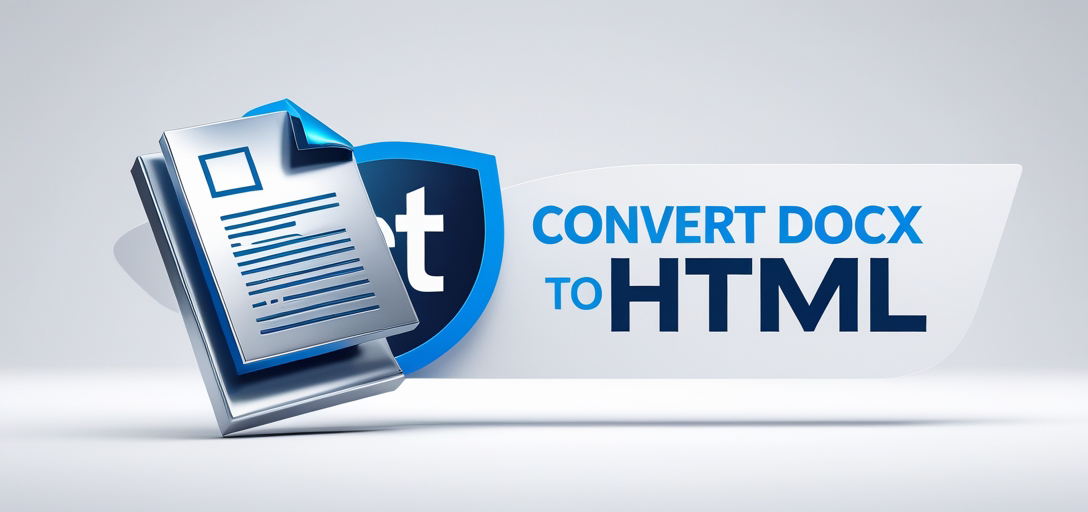How to Convert DOCX to HTML Using GroupDocs.Viewer for .NET
Introduction
Are you looking to seamlessly convert Word documents (DOCX) into web-friendly HTML formats using C#? Whether it’s for content management systems, online document viewing applications, or integrating documents with web interfaces, rendering DOCX files as HTML is a common challenge. This tutorial will guide you through the process of utilizing GroupDocs.Viewer for .NET to achieve this functionality efficiently.

In this comprehensive guide, we’ll explore how to:
- Set up and install GroupDocs.Viewer for .NET
- Render DOCX documents into HTML using C#
- Optimize performance and troubleshoot common issues
By following these steps, you’ll be able to implement robust document rendering in your applications. Let’s dive into the prerequisites before starting with the implementation.
Prerequisites
Before we get started, ensure you have the following:
Required Libraries and Versions:
- GroupDocs.Viewer for .NET version 25.3.0
- .NET Framework or .NET Core/5+/6+ environment setup on your machine
Environment Setup Requirements:
- Visual Studio (2017 or later)
- Basic knowledge of C# programming
Knowledge Prerequisites:
- Understanding of file I/O operations in .NET
- Familiarity with handling exceptions and error management in code
Setting Up GroupDocs.Viewer for .NET
To begin, you’ll need to install the GroupDocs.Viewer library. This can be done using either the NuGet Package Manager Console or the .NET CLI.
NuGet Package Manager Console:
Install-Package GroupDocs.Viewer -Version 25.3.0
.NET CLI:
dotnet add package GroupDocs.Viewer --version 25.3.0
License Acquisition Steps
GroupDocs offers different licensing options, including a free trial, temporary licenses for evaluation, and full purchase options. To start with the trial:
- Visit GroupDocs Free Trial to download the library.
- For longer evaluations, consider applying for a temporary license at Temporary License Page.
- Purchase a full license if you decide to integrate this feature into your production environment from Purchase GroupDocs.
Basic Initialization and Setup
Once the package is installed, initialize GroupDocs.Viewer in your C# project:
using GroupDocs.Viewer;
// Initialize Viewer with a sample document path
using (Viewer viewer = new Viewer("YOUR_DOCUMENT_DIRECTORY\sample.docx"))
{
// Configuration settings will follow here...
}
Implementation Guide
Let’s break down the implementation into distinct features for clarity.
Rendering Document into HTML
This feature involves converting DOCX files to HTML using GroupDocs.Viewer, making them easily embeddable on web pages.
Overview
- Purpose: Convert a Word document (DOCX) into an HTML format with embedded resources.
- Benefits: Easy integration of documents in web applications and content management systems.
Steps for Implementation
1. Configure Output Directory
First, set up the output directory where your rendered files will be saved:
using System.IO;
// Define the output directory for rendered HTML files
string outputDirectory = Utils.GetOutputDirectoryPath();
2. Format for Naming Each Page’s HTML File
Create a naming convention to store each page of the document separately in HTML format:
// Format for naming each page’s HTML file
string pageFilePathFormat = Path.Combine(outputDirectory, "page_{0}.html");
3. Initialize Viewer and Set Options
Configure GroupDocs.Viewer to render your document using embedded resources within HTML files.
using (Viewer viewer = new Viewer("YOUR_DOCUMENT_DIRECTORY\sample.docx"))
{
// Configure options for rendering with embedded resources
HtmlViewOptions options = HtmlViewOptions.ForEmbeddedResources(pageFilePathFormat);
// Render the document to HTML
viewer.View(options);
}
- Parameters Explained:
pageFilePathFormat: Determines where each page of the rendered document will be saved.HtmlViewOptions.ForEmbeddedResources(): Ensures all resources (images, styles) are embedded within the HTML.
Troubleshooting Tips
- Ensure your output directory path is correct and accessible.
- Check for any file permission issues that might prevent writing to disk.
- Validate the format of the DOCX document; unsupported formats may cause rendering issues.
Practical Applications
Using GroupDocs.Viewer, you can integrate document viewing capabilities into various applications:
- Content Management Systems (CMS): Seamlessly display uploaded documents directly on web pages.
- E-Learning Platforms: Provide students with easy access to course materials in HTML format.
- Legal and Financial Services: Allow clients to view contracts or financial statements online securely.
Integration Possibilities
- Integrate with ASP.NET MVC applications for dynamic document viewing.
- Use with Azure services for cloud-based document management solutions.
Performance Considerations
When rendering documents, consider the following tips:
- Optimize Resource Usage: Limit memory usage by processing large documents in chunks.
- Caching Mechanism: Implement caching to reduce load times for frequently accessed documents.
- Asynchronous Processing: Use asynchronous calls where possible to improve application responsiveness.
Conclusion
In this tutorial, you’ve learned how to convert DOCX files into HTML using GroupDocs.Viewer for .NET. This powerful library simplifies document conversion processes and can be seamlessly integrated into various applications. As next steps, consider exploring additional features of the GroupDocs.Viewer API or customizing your implementation to better fit specific use cases.
Ready to implement this solution in your projects? Dive deeper by experimenting with more complex documents and configurations!
FAQ Section
1. What is GroupDocs.Viewer for .NET?
- GroupDocs.Viewer for .NET is a library that allows developers to render documents into different formats, such as HTML, PDF, or images.
2. How do I handle unsupported document formats with GroupDocs.Viewer?
- Ensure the DOCX file format is supported; otherwise, you may need additional processing tools or libraries.
3. Can I customize the output HTML generated by GroupDocs.Viewer?
- Yes, customization options are available through configurations in
HtmlViewOptions.
4. What if my rendered HTML files have missing resources?
- Double-check that embedded resource settings are correctly configured and paths are valid.
5. How do I improve rendering performance for large documents?
- Optimize by processing the document in smaller parts or using asynchronous methods.
Resources
- Documentation: GroupDocs Viewer .NET Docs
- API Reference: GroupDocs API Reference
- Download: GroupDocs Downloads
- Purchase: Buy GroupDocs License
- Free Trial: Try Free Trial
- Temporary License: Request Temporary License
- Support Forum: GroupDocs Support